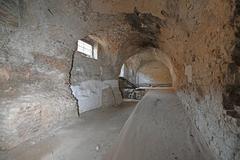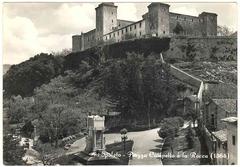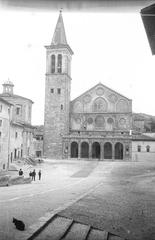Castello di Poreta: Visiting Hours, Tickets, and Historical Sites in Spoleto
Date: 14/06/2025
Introduction
Perched atop the rolling hills of Umbria, Italy, Castello di Poreta stands as a testament to the region’s medieval legacy, architectural ingenuity, and enduring rural culture. Originally a rural villa that evolved into a fortified settlement during the late 13th century, the castle and its surrounding village illuminate the turbulent history and resilient spirit of the Spoleto area. Today, visitors can explore its ancient walls, terraced olive groves, and the spiritual sanctuary of the Church of San Cristoforo, all while immersing themselves in the broader artistic, culinary, and natural riches of Spoleto and Umbria.
This guide provides comprehensive information for travelers—covering Castello di Poreta’s history, architectural highlights, visiting hours, ticketing, accessibility, guided tours, and practical travel tips. Additionally, it highlights the vibrant cultural context of Spoleto, nearby historical attractions, and authentic Umbrian experiences.
Key sources for this guide include Umbria Tourism, the Castello di Poreta official website, and Le Terre di Poreta.
Table of Contents
- Early Origins and Medieval Development
- Fortification and Urban Structure
- Social and Economic Role in the Region
- Decline and Transformation after the 18th Century
- Religious Heritage: The Church of San Cristoforo
- Architectural Features and Preservation
- Visiting Castello di Poreta: Practical Information
- Cultural Context: Spoleto and Surroundings
- Practical Travel Tips
- Frequently Asked Questions (FAQ)
- Visuals and Media
- Related Articles
- Conclusion
Early Origins and Medieval Development
Castello di Poreta originated as a rural villa, reflecting Umbria’s tradition of agricultural settlements. Its strategic location between Spoleto, Campello, and the Fonti del Clitunno placed it at a crossroads of trade and communication in central Italy. By the late 13th century, amidst increasing insecurity from regional conflicts and mercenary threats, the community fortified the village, transforming it into a defensible borgo (Umbria Tourism).
Fortification and Urban Structure
The late 1200s saw the emergence of Castello di Poreta as a fortified settlement. Defensive stone walls enclosed a tight cluster of dwellings, maximizing protection and reflecting the medieval pattern of hilltop fortresses in central Italy. By the 15th century, further fortifications—towers and reinforced gates—were added in response to mercenary raids, cementing Poreta’s status as a strategic stronghold (Umbria Tourism).
Social and Economic Role in the Region
Throughout the Middle Ages and Renaissance, Castello di Poreta served as the administrative and economic hub for surrounding rural communities. Olive groves and vineyards sustained the local economy, and the castle’s elevated position allowed control over trade and movement in the Spoleto valley. Olive oil production remains a defining tradition of the region.
Decline and Transformation after the 18th Century
A devastating earthquake in the 18th century precipitated the gradual abandonment of Castello di Poreta’s fortified core. Many residents rebuilt outside the damaged walls, often reusing materials from the old structures. While no longer a densely populated stronghold, the castle retained its symbolic and cultural significance (Umbria Tourism).
Religious Heritage: The Church of San Cristoforo
Central to the community’s spiritual life, the Church of San Cristoforo (later Santa Maria della Misericordia) features a Madonna image believed to have miraculously survived the region’s earthquakes. The church serves as a place of pilgrimage, reinforcing local religious traditions and continuity (Umbria Tourism).
Architectural Features and Preservation
Castello di Poreta’s medieval fabric is evident in its irregular limestone walls, towers, and terraced olive groves. Restoration efforts have stabilized key structures, preserving the historical character and making the site a notable example of Umbrian fortification (Castello di Poreta official website). The compact village layout and integration of agriculture within defensive walls offer a glimpse into medieval daily life.
Visiting Castello di Poreta: Practical Information
Visiting Hours
Visiting hours may vary depending on the site’s function. As a boutique accommodation, Castello di Poreta is primarily accessible to overnight guests; however, guided tours and special events may grant external visitors access to the castle and grounds during specified hours (Guest Reservations). Always check the official website or contact the property directly for up-to-date visiting hours.
Tickets
- Accommodation guests: Access included with stay—book in advance via the official website or trusted platforms.
- Day visitors: Guided tours (when available) may require advance booking and a small fee (typically €5–€10).
- Public events: Entry fees may apply during festivals or special occasions.
Accessibility
While restoration has improved access, the historic setting involves cobblestone paths and elevation changes. The church is generally accessible, but those with mobility concerns should inquire ahead (Castello di Poreta official website).
Guided Tours and Events
Seasonal guided tours provide historical insights and access to otherwise restricted areas. Annual festivals, such as the Feast of Santa Maria della Misericordia and Spoleto’s Festival dei Due Mondi, often include events in or near Poreta.
Nearby Attractions
- Spoleto: Renowned for its Roman Theatre, Rocca Albornoziana fortress, and the Festival dei Due Mondi (Umbria Tourism).
- Fonti del Clitunno: Picturesque springs and a UNESCO World Heritage Site.
- Monteluco Forest: Hiking trails and spiritual retreats (Le Terre di Poreta).
- Trevi and Foligno: Hill towns known for olive oil, festivals, and medieval architecture.
Cultural Context: Spoleto and Surroundings
Historical and Artistic Heritage
Spoleto’s roots reach back to the Iron Age, evolving into a Roman colony in 241 BCE. The city is home to major historical sites—Roman Theatre, Arch of Drusus, Rocca Albornoziana, and the Cathedral of Santa Maria Assunta (Umbria Tourism).
Festivals and Contemporary Culture
The Festival dei Due Mondi attracts international artists and audiences, blending opera, dance, theater, and contemporary art (Journey Gourmet). Additional events and exhibitions enliven the region year-round (Le Terre di Poreta).
Gastronomy and Local Products
Umbria’s cuisine features truffles, porcini mushrooms, cured meats, and robust wines like Sagrantino di Montefalco. Olive oil from the region is celebrated for its quality, with tastings and tours available at local estates (Le Terre di Poreta).
Experiential Tourism
Outdoor activities include hiking, cycling, horseback riding, and truffle hunting. The area’s scenic trails and rural experiences are ideal for cultural immersion (Le Terre di Poreta).
Practical Travel Tips
- Transportation: A car is recommended for reaching Poreta and exploring Umbria. Parking is available on-site (Guest Reservations).
- Best Time to Visit: Spring and autumn offer mild weather and vivid landscapes. Summer is lively with festivals.
- Accommodation: Book early during peak seasons and festivals.
- What to Bring: Comfortable shoes, layered clothing, and a camera for panoramic vistas.
Frequently Asked Questions (FAQ)
Q: What are the visiting hours for Castello di Poreta?
A: Hours vary. Guests with reservations have access; guided tours for day visitors are by arrangement.
Q: How much do tickets cost?
A: Accommodation includes access; guided tours typically cost €5–€10.
Q: Are guided tours available?
A: Yes, often by advance booking, especially during peak tourist seasons.
Q: Is Castello di Poreta accessible for visitors with disabilities?
A: Some areas are accessible, but the terrain is uneven; contact the property for assistance.
Q: What are nearby historical sites to visit?
A: Spoleto’s Roman Theatre, Fonti del Clitunno, and Monteluco Forest are all within easy reach.
Visuals and Media
Entrance gate of Castello di Poreta showcasing medieval stone walls and archway.
Interior view of the Church of San Cristoforo highlighting the miraculous Madonna image.
Explore additional images and virtual tours via the official Castello di Poreta website.
Related Articles
Conclusion
Castello di Poreta is more than an architectural relic—it is a living symbol of Umbria’s medieval history, rural traditions, and cultural continuity. Whether you are an overnight guest, a day visitor on a guided tour, or a traveler exploring the broader Spoleto region, the castle offers a captivating window into the heart of central Italy. Plan your visit with official resources, engage with local traditions, and immerse yourself in the timeless beauty of Umbria.
For more information, consult Umbria Tourism, the Castello di Poreta official website, and Le Terre di Poreta. Enhance your experience by downloading the Audiala app for guided tours, event updates, and insider tips.
References and Further Reading
- The Borgo di Poreta, Umbria Tourism, 2024
- Castello di Poreta e Territorio, Castello di Poreta official website, 2024
- Visiting Castello di Poreta, Le Terre di Poreta, 2024
- Spoleto Historical Sites, Umbria Tourism, 2024
- Exploring Castello di Poreta, Il Luoghi del Silenzio, 2024
- Cultural Events and Festivals in Spoleto, Journey Gourmet, 2024
- Spoleto Travel Guide, Strictly Italy, 2024
- Guest Reservations Castello di Poreta, 2024


